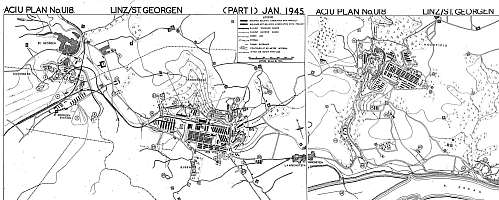Scope
The KZ Gusen I, II and III concentration camp complex was the largest and most brutal within the Mauthausen-Gusen camp system.
In fact, in 1944 the central KZ Gusen complex, with 25,000 inmates, reached double the number of inmates as in the related camp at Mauthausen, which had some 12,000 inmates at that time.

This vast increase of inmates was due to the foundation of KZ Gusen II a few hundred meters west of KZ Gusen I. KZ Gusen II housed some 16,000 inmates deported for the construction and operation of the huge underground plant at St. Georgen/Gusen (B8 BERGKRISTALL-ESCHE 2) and Langenstein (KELLERBAU).
The B8 BERGKRISTALL project involved the first serial assembly of a jet in aviation history, the Me-262. The strategic importance of this project for the Nazi war effort prompted the SS, who managed the construction and operation of the Gusen camps, to create such brutal working-conditions that death rates reached 70 to 90%, depending on the weather conditions.
So few survived the KZ Gusen II “extermination camp”, as the KZ Gusen I survivers call it, that nearly all of KZ Gusen II history was forgotten during the last decades.
Thanks to the international cooperation of KZ Gusen survivors and eye-wittnesses from the local population around the three camps, we are able to make some general information about this giant but forgotten complex available to historians, students and other interested people.
We also see this website (derived from our former "KZ Mauthausen-Gusen Info-Pages" that went online already in 1997) as the voice of some 40,000 forgotten KZ Gusen victims.
In fact, this forgotten group of victims represents the largest group of victims within the “Mauthausen” system of more than forty camps spread all over “Austria” in that awful period between 1938 and 1945.
Note as well that more people died in KZ Gusen I , II and III than in the related Mauthausen central camp. All in all, the 40,000 KZ Gusen victims represent nearly one-third of all the concentration camp victims on “Austrian” territory!
Furthermore, nearly 80% of all Germans and Austrians or Poles sent to “Mauthausen” actually died at Gusen. Also nearly 70% of all the Spaniards! The deaths attributable to KZ Gusen should also include up to three thousand KZ Gusen inmates like Marcel Callo who were re-transferred to the “Sanitaets-Lager” outside of the Mauthausen central camp to die from the horrible conditions at KZ Gusen II.
The high mortality rate at KZ Gusen has left us very few survivors. Thus, the history of these camps has been more or less unknown for decades.
However, the official transfer of the Memorial Crematorium KZ Gusen to the Republic of Austria by former inmates of KZ Gusen in 1996 and the work of the Gusen Memorial Committee helped to stimulate more professional academic research on this very important, but forgotten, concentration and “extermination” camp complex in the last three decades.
Please also be aware that we collect any information/materials available about the former KZ Mauthausen-GUSEN camps. So, should you have some, please don´t hesitate to contacting us.
We will make all proper material available via our collections to any interested students or researchers in rememberance of the tens of thousands of forgotten KZ Gusen victims.
The following academic thesis were done with material from our archives meanwhile:
- Duriez, Claire: GUSEN, Camp Annexe de Mauthausen, camp de concentration nazi en territoire autrichien, mai 1940 – mai 1945, mémoire de maitrise sous la direction du Professeur André GUESLIN, Département d´Histoire, Université Paris VII Denis Diderot, Paris, Année universitaire 1997/1998
- Hoelzl, Elisabeth: Holocaust in der Literatur (Holocaust within Literature; a commented translation of Chemin de Croix en 50 Stations by Bernard Aldebert) -142 p. Ill. Language: German; University of Salzburg, 1996 (Bestandsnachweis; HB M1 268749 II 103 -> III Hoel-8)
- Rief, Silvia: Wir schmieden das Schwert (Forging the Sword; Work-Experience of an Austrian Civilian at the Steyr-Daimler-Puch Plants at Letten and within KZ Gusen Concentration Camp) -182 p. Ill. Laguage: German; University of Vienna, 1996 (Bestandsnachweis; 078 F–> MGW-5286)
- Vitry, Stephanie: Les morts de Gusen, camp de concentration Autrichien(The victims of KZ Gusen in accordance to registers between April 1943 and May 1945) -Language: French; University of Paris I – Pantheon-Sorbonne (CRHMSS), 1994
#RememberGusen